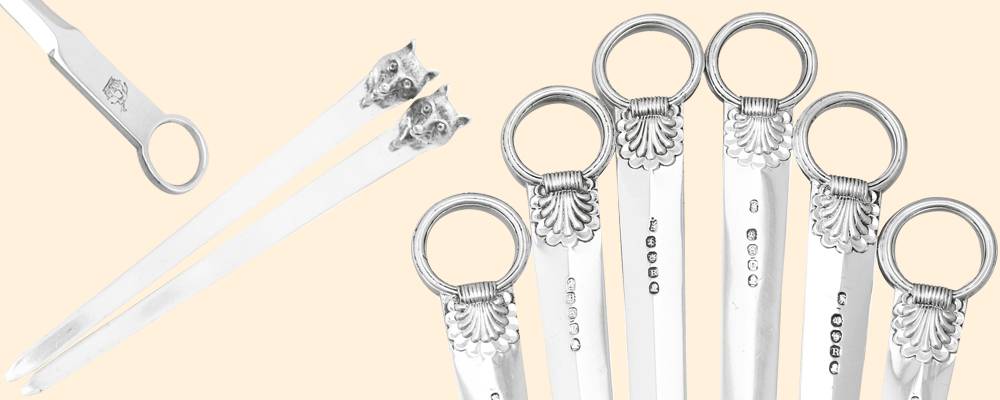Silver Skewers
Antique and Vintage Silver Skewers for Sale
Explore our fine collection of antique and vintage silver skewers for sale. Our collection includes silver meat skewers from many eras including Victorian examples through to more contemporary times.
All antique skewer purchases will arrive with a complementary insurance valuation and will include free global shipping.
Andrew Campbell, using his 40 years’ experience within the antique silver industry, handpicks all silverware for sale.

The physical design of the piece allows the skewer to be pulled from the joint using the ring loop finger piece. As this upper portion would protrude out of the meat join on the dining table, skewers are commonly engraved with initials or heraldic crests – denoting the family name of the hosting household.
The ornamentation to the skewer developed to include bead and reed ornamentation to the finger piece and shell designs in conjunction with the tapering shaft, reflecting that of a spoon’s heel. These additions to decoration enabled skewers to be produced and included within 19th century canteens of cutlery, incorporating the popular cutlery pattern elements.
The design of a silver skewer was ornate. The upper portion of the skewer often featured a ring loop finger piece, making it easy to pull out of the joint when serving. This exposed upper section was commonly engraved with initials or heraldic crests, signifying the hosting household's family name.
Silver Skewers Frequently Asked Questions
Silver skewers have a unique historical role in culinary practices. Traditionally, skewers were elongated pieces of wood or metal used for securing pieces of food together during the cooking process, often removed before serving. However, silver skewers deviated from this norm and served a distinct function.
One of the secondary functions of silver skewers was to serve as a tool for testing the doneness of the meat. Because silver is an excellent heat conductor, these skewers allowed chefs or cooks to insert them into the meat, and the skewer's heat conductivity would reveal whether the meat was fully cooked from within.
Over time, silver skewers incorporated various ornamental elements. Bead and reed ornamentation adorned the finger piece, and shell designs were integrated into the tapering shaft, mimicking the aesthetic of a spoon's heel. These decorative enhancements made silver skewers visually appealing and aligned them with popular cutlery patterns of the 19th century.
Larger skewers were used for beef or veal joints, whereas the smaller would-be ornate additions to poultry/game such as pheasant. Toward the end of the 19th century, silver skewers began to lose popularity. The shift in popularity was partly due to the availability of silver carving forks within formal dining services. As silver carving forks became more readily accessible, the exclusive use of silver skewers for meat carving declined.










